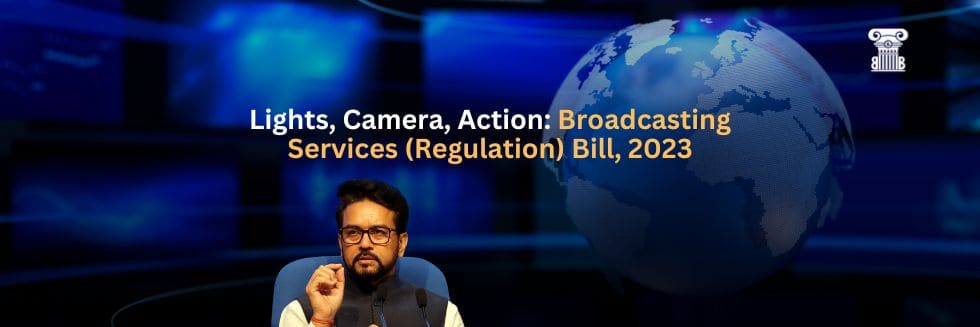Step into the future of broadcasting regulation with the introduction of the draft Broadcasting Services (Regulation) Bill, 2023. Brimming with transformative potential, this forward-thinking legislation is poised to reshape India’s broadcasting landscape embracing cutting-edge technologies and evolving content delivery platforms. From digital cable TV to Over-the-Top (OTT) content and Internet Protocol Television (IPTV), every facet of modern broadcasting falls under its purview and the future of content creation hangs in the balance.
INTRODUCTION:
On November 10, 2023, the Ministry of Information and Broadcasting (MIB) issued the draft Broadcasting Services (Regulation) Bill, 2023 to solicit feedback from the public and concerned stakeholders. This bill represents a significant overhaul of the regulatory framework governing the broadcasting sector in India aiming to address emerging technologies and modes of broadcast including digital cable TV, Over-the-Top (OTT) content, digital news, Direct-to-Home (DTH) and Internet Protocol Television (IPTV).
The Bill explicitly states that the provisions of other legislations such as the Information Technology Act of 2000 and the Telecom Regulatory Authority of India Act of 1997 will not be overridden by the Bill but will instead complement it. This article delves into the key provisions and implications of this proposed legislation.
BACKGROUND:
The proposed Broadcasting Services (Regulation) Bill, 2023 seeks to replace the three-decade-old Cable Television Networks (Regulation) Act, 1995 and introduces substantial changes to the regulatory landscape governing broadcasting in India. Notably, the bill clarifies its supplementary nature to the Information Technology Act, 2000 and the Telecom Regulatory Authority of India Act, 1997 ensuring coherence with existing statutory frameworks.
KEY CHANGES:
- Expanded Definitions: The Bill broadens the scope of “Broadcasting” to encompass the transmission of audio, visual or audio-visual content through various networks including cable, satellite, internet and terrestrial platforms. This expanded definition brings OTT platforms like Netflix and Amazon Prime under regulatory purview marking a significant departure from the Cable Television Networks (Regulation) Act, 1995.
- Programme and Advertising Code: A central feature of the Bill is the introduction of a Programme and Advertising Code empowering the Central Government to regulate content disseminated by broadcast network operators. This Code applies not only to traditional broadcasters but also extends to OTT platforms and digital news providers. Compliance with the Code is mandatory ensuring that programmes and advertisements align with prescribed standards of decency, integrity and public interest.
- Self-Classification and Access Control: Broadcasters are mandated to classify their programmes based on prescribed rating systems facilitating informed viewing choices for audiences. Additionally, stringent access control measures are proposed for content classified as restricted such as adult-oriented material safeguarding vulnerable viewers.
- Accessibility Guidelines: Recognizing the rights of persons with disabilities, the Bill mandates broadcasters to ensure accessibility by incorporating features such as subtitles, audio descriptions and sign language interpretation. An annual accessibility audit report is required underscoring the commitment to inclusivity within the broadcasting ecosystem.
- Regulatory Framework: The Bill advocates a three-tiered regulatory mechanism comprising self-regulation by broadcasters, oversight by Self-Regulatory Organizations (SROs) and adjudication by the Broadcast Advisory Council (BAC). This multi-tiered approach aims to foster compliance with the Programme and Advertising Code while providing avenues for grievance redressal and appeals.
- Right of way: The bill also incorporates provisions for infrastructure sharing among broadcasting network operators and the carriage of platform services. Additionally, it streamlines the Right of Way section to handle relocations and alterations more efficiently and establishes a structured dispute resolution mechanism.
- Government Powers and Penalties: The Bill vests the Government with extensive powers including inspection, seizure of equipment and prohibition of broadcasting services in the public interest. Statutory penalties ranging from advisories, censure and warnings to imprisonment are prescribed for non-compliance ensuring enforcement efficacy and accountability.
CRITICISM AND STAKEHOLDER CONCERNS:
- Inclusion of OTT Platforms: The bill’s inclusion of OTT platforms under the same regulatory framework as traditional broadcasters has drawn significant criticism. OTT platforms operate on a user-driven model where content is “pulled” by users, unlike traditional TV networks that “push” content to viewers. This distinction raises concerns about whether censorship regulations should apply similarly to both modes of content delivery.
- Sections 19 and 20: Sections 19 and 20 of the proposed legislation have been highlighted as pivotal areas of concern. Section 19 mandates compliance with yet-to-be-developed Programme and Advertising Codes while Section 20 poses challenges for independent journalists by potentially restricting their ability to publish news deemed unfavorable to the government.
- Overlap with Existing Laws: Critics have pointed out potential overlaps between the proposed Bill and existing regulations governing online content. This dual regulatory framework could pose administrative burdens and create confusion for OTT platforms and digital content publishers impacting operational efficiency.
- Composition of the Broadcast Advisory Council (BAC): Concerns have been raised regarding the composition of the BAC particularly regarding the appointment process for its members. Apprehensions exist that government involvement in appointing members could compromise the council’s independence and impartiality potentially influencing regulatory decisions.
CONCLUSION:
In conclusion, the draft Broadcasting Services (Regulation) Bill, 2023 marks the beginning of a new era in broadcasting regulation in India aiming to modernize the regulatory framework to keep pace with technological advancements and evolving consumer preferences.
While the Bill introduces several progressive provisions such as expanded definitions, accessibility guidelines and a three-tiered regulatory mechanism, it also faces criticism and concerns from various stakeholders regarding its treatment of OTT platforms, potential restrictions on independent journalism and overlaps with existing laws.
As the Bill undergoes further scrutiny and deliberation, it is crucial to strike a balance between regulatory objectives and safeguarding fundamental freedoms to ensure a robust and inclusive broadcasting ecosystem for all.
_________________________________________________________________________________________________________
This article is written and submitted by Sanskar during his course of internship at B&B Associates LLP. Sanskar is a 5th year BB.A. LL.B student at Geeta Institute of Law.









